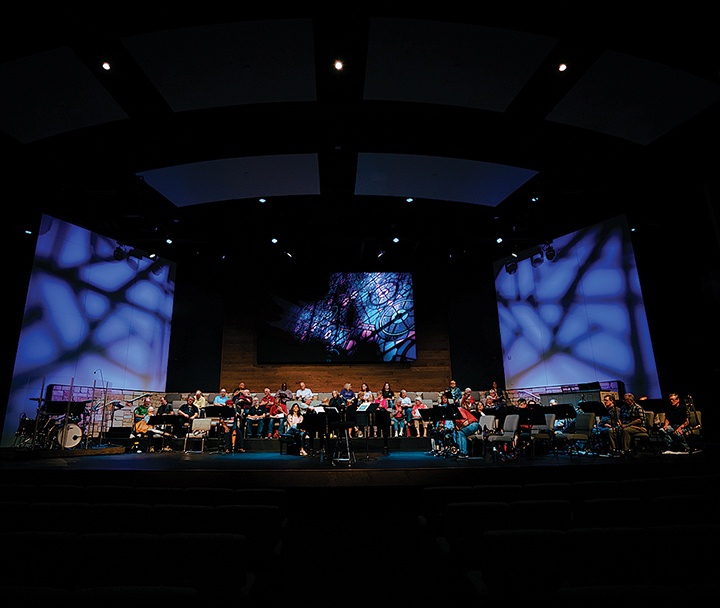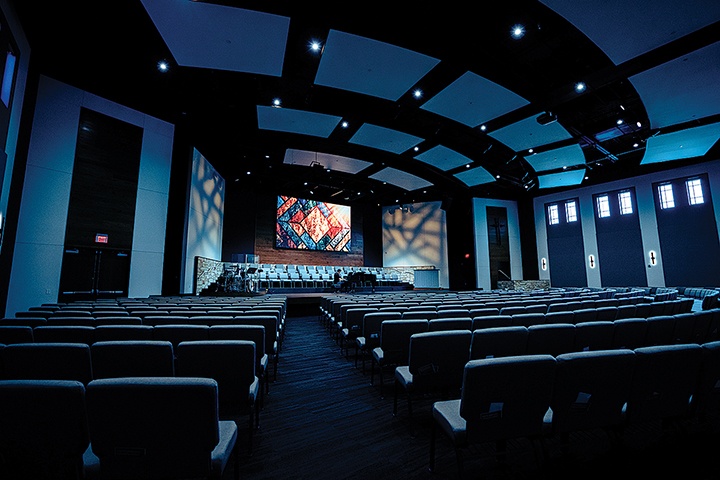
If the goal is to really reach people (and it is), there’s a shift underway towards things like integrated architecture, spatial audio and more.
So, what do I mean by all that?

Principal
CSD Group, Inc.
Well, through my work with our firm, I’m finding that some of the newest trends are decidedly old school-meets-new school.
#1: Having a “platform look” — one that doesn’t change — as part of your church’s branding. A platform look helps people to connect and builds trust. As an example, think of Joel Osteen’s stage with the ever-present giant, spinning globe. You can picture it, right? That’s the point.
This represents what we call “studio church platforms,” something we’re implementing a lot of lately. The idea, here, is to have a flexible space as a part of the platform, but then have it anchored by “sets,” or a look that never changes. This way, when people see the space on video or in person, they can tell exactly where they are. A platform look relies less on the people on stage and more on the statement made by the “look” of the platform.
In coming years, this method will change the way we think about church audio/video/lighting and architecture.
Think about some of your most trusted shows — Johnny Carson or Jimmy Fallon, for instance. The sets don’t change, yet there’s a space for everything. You see a shot of the set, and you know and trust. We’re observing this in a lot of new churches, and I believe the ones that adopt it first will reap the biggest benefits.

#2: LED-wall integration into church architecture. LED walls are a huge trend right now. Gone are the days of a black stage with screens and lights, or just windows; we’re seeing that, with architecture, you can change the dynamics of a worship space while having a set that doesn’t need to change every month.

LED walls let you mimic stained glass windows on the walls, or a view of the outdoors. You can use them in backdrop effects and incorporate logos. We’re seeing LED walls act as digital skylights instead of installing real ones. We’re even seeing churches use fully immersive LED wall stages and ceilings that enable a space to serve dual purposes: for worship on the weekends and as a movie / commercial set, which can be rented out, during the week. This configuration has the added benefit of helping pay for the facility and the technology.
#3: Cinematic cameras and robotics. Movement and focus — the tools that master filmmakers use to tell stories — are being used more and more to create a way of storytelling in the Church. Movement can be achieved with the focus of lenses, as well as from movement of the camera using jibs (the projecting arms of cranes) and track.
Static images in which everything is in focus are boring and won’t keep people’s attention with all the other content floating around. You need your video to look great and have that “focusing” movement to keep viewers locked in.
Pushing cameras on tracks involves manpower, whereas using jibs requires the use of robotic cameras on tracks that can move side to side and up and down, creating sweeping moves.
Both help capture and keep the audience’s attention.

#4: Spatial audio is on the rise! You hear a lot about spatial audio on iTunes, and now you’ll start experiencing it in more and more churches.
I’m an early adopter of this 360-degree sound format and have been designing these systems for more than 25 years. I learned most of what I know about it during my time working at Sight & Sound Theaters in Lancaster, Pa., where Bible stories come to life on the stage. It was very effective, as the sides of the stage in this space surround the audience.
In using spatial audio at Sight & Sound, we had to think differently about how sound affects people. Through the years, people have started to see the benefit of this type of connection. Effectively, it gives every person a unique experience — one might say that it harkens back to “old school” sound, before big mono audio systems became the norm.
With spatial audio, viewers can actually hear where people are on stage. It locates congregants to the reality of what they’re seeing and really starts to make them forget about the sound system, and that they’re not hearing them directly. Very powerful.
When a “surround” aspect is incorporated into the space, the room becomes multifunctional: good for speech, but also great for worship and congregational connection.
When we think of worship technology, the “flash” of some modern churches might immediately come to mind; but actually, those churches represent a very small subset of the nation.
In my experience, a church can benefit much by exploring new (if, in some ways, old-school) ways of thinking and reaching people with its audio, video, lighting and acoustics.




Extraordinary piece of content and I couldn’t want anything more than to divide this between my loved ones
Only this post proved that any body is not equal you and your level.
Great piece of content and I would love to share this among my friends and family